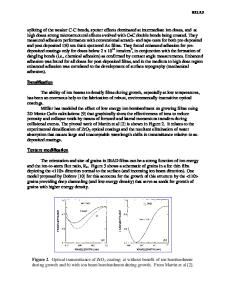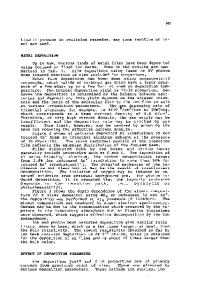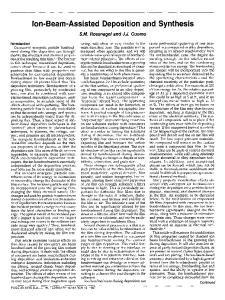Ion Beam assisted Deposition of Titanium Nitride
- PDF / 369,737 Bytes
- 6 Pages / 420.48 x 639 pts Page_size
- 66 Downloads / 373 Views
ION
BEAM ASSISTED
DEPOSITION
OF TITANIUM NITRIDE
G.K. HUBLER, D. VANVECHTEN*, E.P. DONOVAN and R.A. Naval Research Laboratory, Washington, DC,20375 *Sachs-Freeman Associate at NRL
KANT USA
ABSTRACT The composition of titanium nitride films prepared by ion beam assisted deposition was studied as a function of the partial pressure of N2 gas in the deposition volume, and as a function of the impingement 'ratio of nitrogen ions (500 eV) to evaporated titanium atoms. The amount of nitrogen incorporated from the ambient gas was derived by subtraction of the fraction introduced by the ion beam. It is shown that the primary effects of ion bombardment are an increase in the sticking coefficient and a reduction in the number of active surface adsorption sites. INTRODUCTION Ion beam assisted deposition (IBAD) refers to the process wherein evaporant atoms produced by physical vapor deposition (PVD) are simultaneously struck by a flux of low energy ionsl. The extra energy imparted to the deposited atoms causes bulk atomic displacements and surface atom migration. This can result in improved film properties2,3 which include better adhesion and cohesion of the film, modified residual stress, and higher density when compared to similar films prepared by 5 PVD4, . When the ion beam or the evaporant is a reactive species, compounds such as refractory Si 3 N4 can be synthesized at very low temperatures6 For IBAD compound synthesis the gaseous (beam) atomic species that are incorporated into the film arise from two mechanisms: direct ion implantation and adsorption of ambient gaseous atoms on the growth surface. At typical operating pressures of 10-4 Torr, the latter effect can dominate for reactive combinations such as Ti and N. It is of basic interest to the understanding of IBAD to determine the fraction of beam atoms that are incorporated into the film from each mechanism as a function of the fluxes of evaporant atoms, energetic ions, and ambient gas molecules. The present study focuses on a determination of the composition and thickness of TiN prepared by IBAD as a function of the partial pressure of N 2 gas and the impingement ratio of 500 eV nitrogen ions to evaporated Ti atoms. It extends previous 7 8 work , by including additional data and by introducing a phenomenological model that predicts the amount of gas incorporation. EXPERIMENTAL
PROCEDURE
Typical base pressure of the cryopumped bell-jar deposition 7 chamber is 3x10Torr without baking. A constant flow rate of 7 sccm of nitrogen through the ion source raises the pressure to 4 2x10° Torr. The electron beam evaporation of Ti with a deposition rate of 9.3 R/s is controlled with a quartz crystal balance which is shielded from the ion beam. Gettering by the Ti flux on the walls of the chamber causes the pressure to drop Mat. Res. Soc. Symp. Proc. Vol. 128. '1989 Materials Research Society
56
introduced supply of N 2 gas is An auxiliary to - 10-6 Torr. pressure in the the total through a needle value to control 4 The ion gun discharge, cathode, Torr. range > 10-6
Data Loading...










